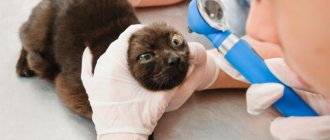One of the most common health problems in cats is associated with infection by various parasites, in particular roundworms. This is one of the most common types of parasites, and almost every pet will get sick from it at least once in its life.
Even pets who do not go outside are not immune from this - roundworm eggs can easily be brought on shoes or unprocessed food.
Fortunately, the prognosis for treating roundworms in cats is favorable, but it all depends on the general condition of the pet and how quickly the disease was detected.
Signs of roundworms
To detect roundworms in your pet’s body, you need to be very attentive to his well-being. Symptoms:
- The cat often licks its anus.
- Nausea.
- Rapid weight loss.
- The belly becomes round.
- The cat constantly coughs and wheezes.
- Brittle wool.
- Periodic convulsions.
- Stomach upset.
Treatment. How to get rid of worms?
Antiparasitic drugs are used for treatment . There are many medicines with different compositions on the market. Everyone has their own dosage, as well as the course of their taking. The veterinarian determines the pet’s personal characteristics and then identifies the type of worm. After all, different drugs are used against each of them. There are also universal medications , but they are not so powerful and are not always able to help in later stages. They are used rather for prevention in the first stages of the disease.
For this reason, you cannot treat yourself
. After all, if you do not identify a specific worm, treatment will simply be to no avail, and this, in turn, means that the parasite will only develop and gain strength. This is much more difficult to cure.
In addition to tablets, drops . This format is sometimes more convenient than the tablet format, which is not so easy to give to a cat. Oral, they are given to the animal twice at intervals of two weeks until complete recovery.
However, it is worth remembering that if the treatment has been going on for more than a month, and there are almost no results, this means that the parasites have already become accustomed and adapted to the drug. It is worth remembering what medications the animal has already been treated with, because if there is a change of veterinarian to another, it is important for him to know so as not to repeat it.
It is also important to maintain sterility and disinfect any surface that your pet touches. You also need to clean him himself, because the eggs spread through the fur as well. The larvae die from any household chemicals, so the use of bleach is not always necessary, although it is desirable. However, if you don’t have it on hand, even regular soap will do just fine.
Routes of infection
It can become infected in the following ways:
- From contact with a sick pet. Cats suffering from helminthic infestations can carry their eggs on their fur. The main number of eggs accumulates around the anus. If infected cats constantly lick themselves, then in this way they only increase the chances of infecting other pets.
- If insects eat food contaminated with parasites, they become living carriers.
- When a cat is infected with roundworms, she spreads worm eggs throughout her fur, and therefore kittens that drink milk can become infected.
- If you are undergoing treatment in a clinic, then disinfect your home.
Since the cat can pick up the eggs again, and then she will get toxocariasis again.
- When your cat often walks outside on his own, he is more susceptible to infection. This is due to the fact that she can eat grass, contaminated food scraps, and so on. But also infected cats should not be walked, as they may shit, and therefore they leave worm eggs. This way the parasites will spread further.
Diagnostics
Even the trained eye of a professional and experienced veterinarian is not able to determine the presence of worms without tests and additional checks. Of course, it is theoretically possible to suspect this diagnosis, but confirmation is simply necessary. One hundred percent results are given by stool tests , in which the veterinarian detects the presence of Toxocara eggs or larvae.
It is better to carry out tests at certain intervals , which are determined by the doctor. In general, this is from a week to ten days. This is due to the fact that the first test is not always able to show a positive result for the presence of eggs. There are still few of them in the body and they have not become so sexually mature. The feces themselves should be collected in the morning, because the chance of finding eggs and larvae is much higher at this time than in the daytime, and especially in the evening.
However, diagnostics and tests in general are not always carried out. Often, veterinarians recommend deworming for prevention . The larvae and eggs are still weak and have not developed. Therefore, this procedure will quickly eliminate the infection. If the symptoms continue, then more comprehensive treatment is prescribed. It includes not only regular tests and medications, but also a review of the pet’s entire life: from physical activity to feeding.
Of course, the method of preventive deworming is not the most useful. It can negatively affect not only worms, killing them, but also poison the pet’s body, especially if he has a personal intolerance. That is why we recommend contacting a veterinarian. If you treat your pet yourself, there is a risk of harming it even more, weakening its immunity and introducing new diseases that will be difficult to treat compared to the previous ones.
It is worth saying that this method gives a ninety percent accurate result on the absence or presence of parasites in the feces and, accordingly, in the animal’s body. This occurs because dead worms, larvae and eggs are found in the stool the next day. It is then that analysis must be done to confirm their death. Some claim that the drugs are so strong that the parasites simply dissolve and cannot be detected. However, this is more a lie than the truth. Sometimes doctors justify such preventive actions because they did not conduct a proper analysis and it turns out that they gave drugs to absolutely healthy cats, putting their immunity and health at risk.
Life cycle
On average, it takes approximately 14-20 days from egg to maturity. The roundworm Toxocara cati is considered the most common; below we will talk in more detail about their life cycle.
The definitive host plays a significant role for these intestinal worms. In intermediate stages, roundworms can live in beetles, mice, grasshoppers and chickens.
When the eggs enter the gastrointestinal tract, larvae then develop from them. Their size usually does not exceed half a millimeter. After this, they independently penetrate the bloodstream, so the infection spreads throughout the body.
The body tries in different ways to remove parasites at the development stage, so a large amount of sputum is formed. But this method of struggle does not help, and a large amount of sputum causes the pet to have difficulty breathing.
In the cavity of the small intestine, the parasites already develop into a sexually mature individual. When roundworms develop, they are capable of releasing an incredibly large number of eggs into the animal's feces. Scientists have calculated that approximately 1 g of feces can contain up to 120 thousand future worms.
Causes
The causes of roundworms in cats are:
- Sick animals.
- Ingestion of contaminated water, sick insects - flies, fleas, grasshoppers, etc.
- Eating food infested with larvae, raw or poorly cooked meat of infected animals, fish.
- Licking paws after walking down the street or visiting a public litter box.
- Eating infected mice.
Infection of kittens occurs either in the womb, when larvae migrating through her body penetrate the placental membrane, or through mother's milk.
If milk containing larvae is ingested, the prepatent period lasts 21-30 days. When swallowing an egg, this period lasts 58 days, and when eating a rodent, it lasts 21 days.
Worms developing in the body of a small kitten cause severe intoxication, clog the intestinal loops, and sometimes break through its thin walls. These factors lead to the inevitable death of kittens.
How to treat?
Kanikvantel plus
The drug is considered the best antiparasitic drug at this time. There are no side effects with this medicine, but it is highly effective against different types of worms.
The product is also allowed for kittens who have reached 3 weeks of age.
Prazitel
For the treatment of kittens, the drug is mainly used in the form of a suspension. And adults are given the same drug in tablet form to remove worms. If there are a lot of parasites in the body, then the course of treatment should be repeated after 2 weeks.
Dironet
Dironet suspension is effective against roundworms and tapeworms. It has a fishy smell, so many cats enjoy licking it off. The dosage of the suspension is calculated from the proportion of 1 ml per 1 kg of pet’s weight.
Another effective drug is Drontal.
Treatment
Treatment of roundworms in cats is carried out using anthelmintic tablets. Using them independently, without a veterinarian’s prescription, is strictly prohibited. Such medications have a bad effect on the animal’s liver and kidneys. An overdose can cause severe poisoning.
The doctor selects medications taking into account the pet’s age, weight, and general health. Pregnant cats are treated with special caution - during this period many medications are contraindicated for them. In the first half of pregnancy, the formation of all vital organs and systems occurs, and improper use of anthelmintic medications can lead to miscarriage or intrauterine development disorders. In the early stages, you should not give your cat Prazitel, Kanikvantel-Plus and Polyvercan. Drontal and Dirofen are also contraindicated during this period.
Treatment of ascariasis in cats in early pregnancy is carried out using Milbemax tablets. During this period, it is better to use anthelmintic drugs in the form of solutions that are dripped onto the withers (Profender).
In the second half of pregnancy, treatment can be carried out with Dirofen, Drontal and Gelmimax tablets. However, the latter drug should not be given three weeks before giving birth.
If the animal owner carries out treatment on his own, then it is necessary to buy only products designed to combat round helminths. After carefully studying the instructions for the drug, you should weigh the cat and calculate the optimal dosage.
But self-treatment can be carried out only in emergency cases, in the absence of the opportunity to seek help from a veterinarian. You should not self-medicate kittens under 2 months of age.
First aid
Treatment of toxocaridosis in cats is carried out using a single dose of an antiparasitic drug. The medicine is given to the animal in the morning, on an empty stomach, or in the evening, 2-3 hours after the last feeding.
Pets can be infected with several types of parasites at once, so veterinarians usually prescribe them broad-spectrum medications that destroy flukes, cestodes and nematodes at the same time.
Common antiparasitic medications in tablet form include:
- Albendazole - tablets are used in the treatment of echinococcosis, trichonellosis, ascariasis, toxocariasis, enterobiasis, hookworm.
- Milbemax is an easy-to-use, single-use, complex action product. Helps with cestodiases, nematodes. The medicine is contraindicated in weakened animals and pets weighing less than 0.5 kg.
- Azipirin is a drug based on pyrantel and praziquantel and has a wide spectrum of action. Effective for roundworms in cats and dogs.
- Pratel - tablets containing praziquantel and pyrantel are effective against adult and developing tapeworms. Pratel can be given to both adult animals and kittens.
- Azinosx - the medicine contains praziquantel. Used in the treatment and prevention of tapeworms.
Products used for application to the withers:
- Profender - drops contain emodepside, praziquantel. The product is effective against nematodes and mixed parasitic infestations. Profender cannot be used to treat kittens under 1.5 months old, as well as animals weighing less than 0.5 kg.
- Drontsit is a praziquantel-based solution that can be administered to pregnant cats and newborn kittens.
- Prazicide - can be given to adult pets and young cats over 6 months old.
- Helminthal K is a drug intended for the treatment of ascariasis in cats weighing more than 4 kg.
Basic treatment
Along with anthelmintic medications, the cat is prescribed vitamin complexes. Saturating the body with vitamins, minerals and nutrients allows you to quickly restore the health of an exhausted animal, improve appetite, and increase the protective functions of the body.
Since the eggs laid by helminths mature within 25 days, the cat must be given anthelmintic medication again after 2-3 weeks.
If a cat is prone to allergic reactions, it is given antihistamines during treatment.
To avoid re-infection, you will need to thoroughly disinfect the premises where the cat is.
Possible complications
Treatment should always be completed, as otherwise the parasites can multiply again in the body. Worm attacks greatly weaken the body, so the following complications may occur:
- Everything that the cat eats while eating is not available to her. This is due to the fact that all nutrients are used to support the vital functions of parasites. Therefore, the pet will be sorely lacking proteins, vitamins and other nutrients. If the infection is not detected in a timely manner, it can even lead to death.
- If a huge accumulation of worms appears in the intestines, the passage may close completely. In this case, feces will not be able to come out, and then the intestine may even rupture.
- An infected cat's immunity is greatly reduced. Therefore, any pathologies become dangerous for her, including viruses and various infections.
- Roundworms release many toxic substances during their life. As a result, the metabolism in the fluffy's body is disrupted.
Symptoms
Weak infestation (2-3 worms) is characterized by the cat losing weight against the background of increased appetite. Small kittens suffer from pneumonia, diarrhea, exhaustion, and fever. The abdomen swells, the mucous membranes become pale, which indicates anemia, the kitten is stunted and looks very thin.
The following symptoms may also be present:
- Vomit.
- Fidgeting with the anus on the carpet.
- Disheveled wool.
- Souring of the corners of the eyes.
- Cough.
- Blood in the stool.
- Cramps.
Parasites living in the intestines lead to the loss of most nutrients, gradually depleting the cat's body. If the infestation is severe, she may completely refuse to eat.
Prevention
- The easiest way is to prevent infection, because then you won’t have to fight roundworms. Therefore, once every 2-3 months you need to deworm your pet with special preparations. Before this procedure, it is important to consult with an experienced veterinarian.
- Always inspect your pet and occasionally remove its feces. After all, this is the only way to be sure whether your pet is infected with parasites or not.
To avoid many problems, you should make it a habit to wash your hands thoroughly with soap after handling pets. Good health to you and your furry!
The danger of toxocariasis for animals and humans
Typically, toxocariasis is easy to treat, it all depends on the general condition of the animal and the stage of the disease.
Roundworms are most dangerous for small kittens, which can even die if the disease is not treated in a timely manner. But for most adult cats with normal immunity, toxocariasis is not life-threatening.
Most owners who have discovered parasites in their pet are wondering whether feline roundworms are transmitted to humans.
Unfortunately, most types of this parasite are dangerous not only for cats, but also for other four-legged pets, as well as for humans. Therefore, if roundworms are found in a cat, the whole family will have to give anthelmintic drugs.
What are roundworms and what do they look like?
Roundworms that parasitize cats are roundworms that vary in size and gender. They live most often in the intestines, but are sometimes found in the pancreas, gall bladder, and other organs.
Appearance of cat roundworm
Three species of roundworms parasitize the digestive tract of domestic cats, and all of them are classified as representatives of the nematode suborder Ascaridata of the genus Ascaris. The pathology caused by the presence of nematodes in the body of cats is called toxocariasis.
The causative agents of toxocariasis differ morphologically and also externally.
Table 1. Types of roundworms
| Name | Appearance Features |
Toxocara cati | Light yellow worms, the males of which are up to 5 cm in length, and the females are twice as large. The eggs are brown, spherical in shape, with a thick and rough wall. Their sizes are up to 65×75 microns |
| Toxocara leonina | Yellow helminths, from 6 to 10 cm in length. Eggs are smooth, thick-walled, oval or round, with a diameter of up to 80 microns |
Toxacara canis | Large gray-yellow worms with a length of 94 to 18 cm. In males, the tail is curved. The parasite lays eggs of a round shape, gray in color, in which the cellularity is clearly visible |
Is there immunity against worms?
It is quite difficult to answer this question. Yes, there is a certain immunity in a number of animals, but such immunity is considered non-sterile, and the body cannot completely protect itself from worms.
When eggs enter the intestines, protective internal forces begin to work actively, and the stronger they are, the worse the living conditions for the parasite will be and the faster it will naturally leave its owner.
The main condition for natural control is excellent living conditions, proper nutrition and excellent health of the pet. But still, great attention is paid to preventing invasion.
How to diagnose the presence of roundworms?
To do this, it is necessary to submit a sample of the animal’s feces for analysis three times, at intervals of 10 days. Diagnostics will take almost a month, but it is necessary, since a single collection of biomaterial can show signs of mild infection, while within twenty days from the first visit to the veterinary clinic the next generation of helminths will “hatch”. Feces for research are delivered to the laboratory by the owner of the animal in special containers.
Bloating in a cat infected with roundworms
If a significant amount of parasites is suspected in the digestive tract, an ultrasound of the abdominal organs is performed. Among other things, this allows you to assess intestinal permeability and the condition of the biliary tract. Sometimes, instead of an ultrasound, X-rays using barium contrast are done.
The sooner the owner detects a disease in the cat, the higher the chance of saving it.
When there are signs of the presence of roundworms not (or not only) in the intestinal tract, the animal is prescribed a blood and urine test, as well as an ultrasound of the relevant organs. Based on the diagnostic results, treatment is prescribed.











